Liverpool reach knockout stages after tough win over Salzburg
After a chaotic 1st half, Liverpool finally managed to beat Salzburg, thanks to Klopp’s half-time adjustments, to balance the game’s dynamics.
Starting 11, lessons from 1st game
Based on their last game at Anfield, it was clear that Jesse Marsch must adjust the initial strategy, not allowing that much space and control for Liverpool, as they did in the first 30 minutes on Anfield. There, Salzburg started in a 4-4-2 system, where they had huge issues in defending the #6 space/Fabinho, which allowed Liverpool easy switches towards Robertson & Alexander-Arnold, where they were able to create 2v1 situations against the full-backs, or simply driving forwards, or exploiting spaces between the lines diagonally -as it stretched Salzburg’s 2nd line as well. In the 30th minute, Marsch switched to a 4-3-1-2, which improved their control on Fabinho, plus the counter-attacking dynamics. Learning from this, it was almost sure, that Salzburg is going to play in the diamond, as they eventually did -earlier Brighton also used a narrow 4-3-2-1/4-3-1-2-ish system against Liverpool, which worked quite well to slow down their possession/circulation, as a probable solution. Compared to the 1st game, Marsch only switched in one position, as Haland got to start upfront with Hwang to form the forward duo.
On the other hand, Liverpool’s starting eleven didn’t hold much suprise, Keita started as RCM, after his super return with a goal against Bournemouth. With Fabinho’s absence Henderson started in the number 6 position, plus the usual Mané-Firmino-Salah trio upfront.
Salzburg’s super-agressive start
In the 1 minute, Salzburg immediately had 2 through balls behind Liverpool’s last line, where van Dijk had to make key clearances in both cases. This instantly gave the game’s basic dynamics, especially for the first 10-15 minutes. Salzburg’s defensive approach was based on a relatively high-block, allowing Liverpool to advance from the 1st phase, then pressing them using specific triggers, mostly passes out wide to either the DM/Henderson or to the FBs & passes backwards towards the CBs. With Salzburg’s basic pressing system to start the movement for triggers, both van Dijk and Lovren had space & time on the ball in the 1st phase, from where to exploit this, a usual pattern was a diagonal or through ball behind the last line to Salah & Mané.
Liverpool had serious troubles to surpass Salzburg’s 1st pressing line, often switching from the basic system with Henderson’s dropping movements, to build from the back with 3. Here Henderson mixed his positioning, as he both dropped between the CBs or to the halfspaces, but the reason was to offer less triggers for Salzburg, plus to create a numerical superiority against the 2 CFs. 1 line higher, both CMs/Wijnaldum & Keita dropped deeper, creating a 3-2 structure to build, plus to create a possible 2v1 against the CAM/Minamino. In the meantime, the FBs stayed deeper as well, in order to offer switching options against the diamond structure -not higher, to prevent the last line shift, being closed by Salzburg’s full-backs. There was a bigger emphasis to build on the right-side -also as a result of Salzburg’s pressing-, to exploit Alexander-Arnold’s quality on the ball, to surpass the pressure with ballnear one-twos & off the ball runs -individual dismarking- to separate or with switches to the far-side towards Robertson.
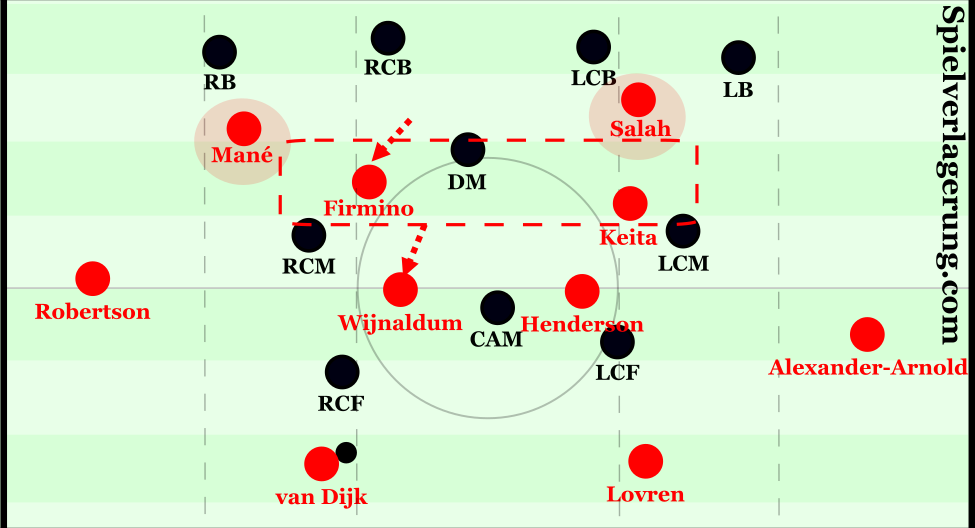
Although as the back 3 often stayed wider -especially van Dijk moved relatively wide-, it created a disconnection between them, preventing the flexible circulation at the back. Also, Salzburg did well to adjust the 1st pressing line, by Hwang also staying wider to prevent the pass to van Dijk Due to this, Liverpool’s circulation became calculable, without being able to move the diamond, forcing them to play on down their right side. After some sequences to build with 3, Henderson stopped to drop deeper, switcing back to build in a 4-2 structure (4 defenders + Henderson & Wijnaldum in front), but the distance issues maintained further, as Alexander-Arnold often got isolated, where he had to operate with long balls towards Salah during the circulation phase. A possible solution would have been to move both Keita-Salah wider, to create a triple-width (or double, with Salah pinning the FB) for a better wide dynamics or a simply putting Alexander-Arnold more to the inside -asymmetric back 4, but the pass to TAA wouldn’t force Pool immediately to an isolated wide zone & forced wide by the diamond shift. Though a wide overload would reduce the central cover, where Liverpool suffered a lot even in the 4-2-2-2.
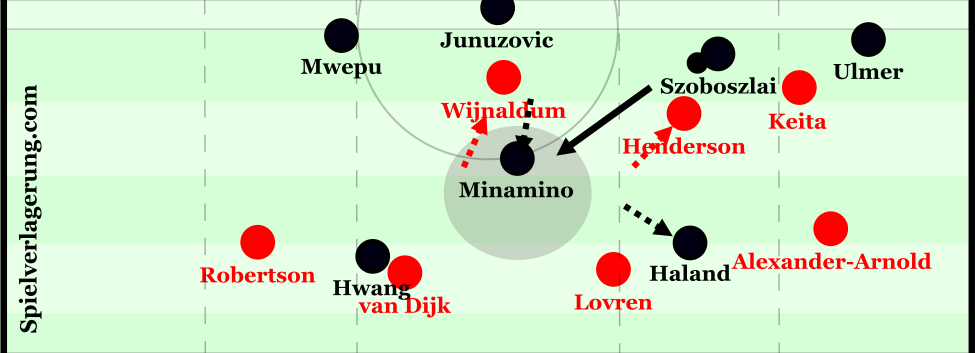
The distances at the back resulted significant issues to defend Salzburg’s counter-attacks. After losing the ball the 2nd line and last line was often wide, without any halfspace control, where Salzburg’s #8s could collect the ball. Plus as Henderson and the 2nd line often moved/shifted out wide, it also left the centre open, where Salzburg could advance through. Even though neither Alexander-Arnold and Robertson were occupying advanced zones, it still opened a channel between them and the CBs, offering even more options for Salzburg’s CFs to exploit -both Hwang and Haland made runs into these channels, often moving the CBs wider out of position, which opened even more central spaces. After winning the ball, the home side had serious chances, as it’s one of the huge advantages of the diamond system that it offers flexible counter-attacking movements and options, exploiting the opponent’s gaps in the last line, with the numerical overload. This was a huge problem for Liverpool at the whole game, even though some changes helped to have better phases after losing the ball, but it only relieved the issue, not solved it. Besides, an interesting tendency was Liverpool’s issues after defensive throw-ins: in these situation their 2nd line often shifted over to the ballnear side, especially Henderson defended in wide positions -prevent TAA or Robertson to push higher-, which opened up the centre completely for Salzburg.
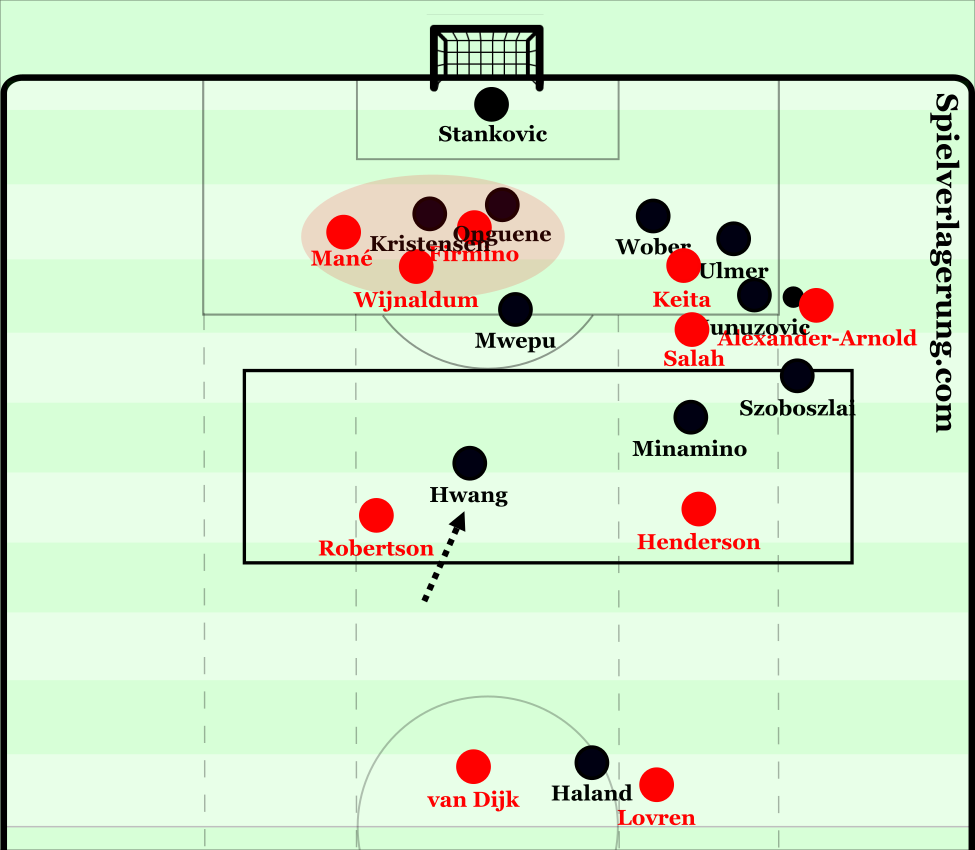
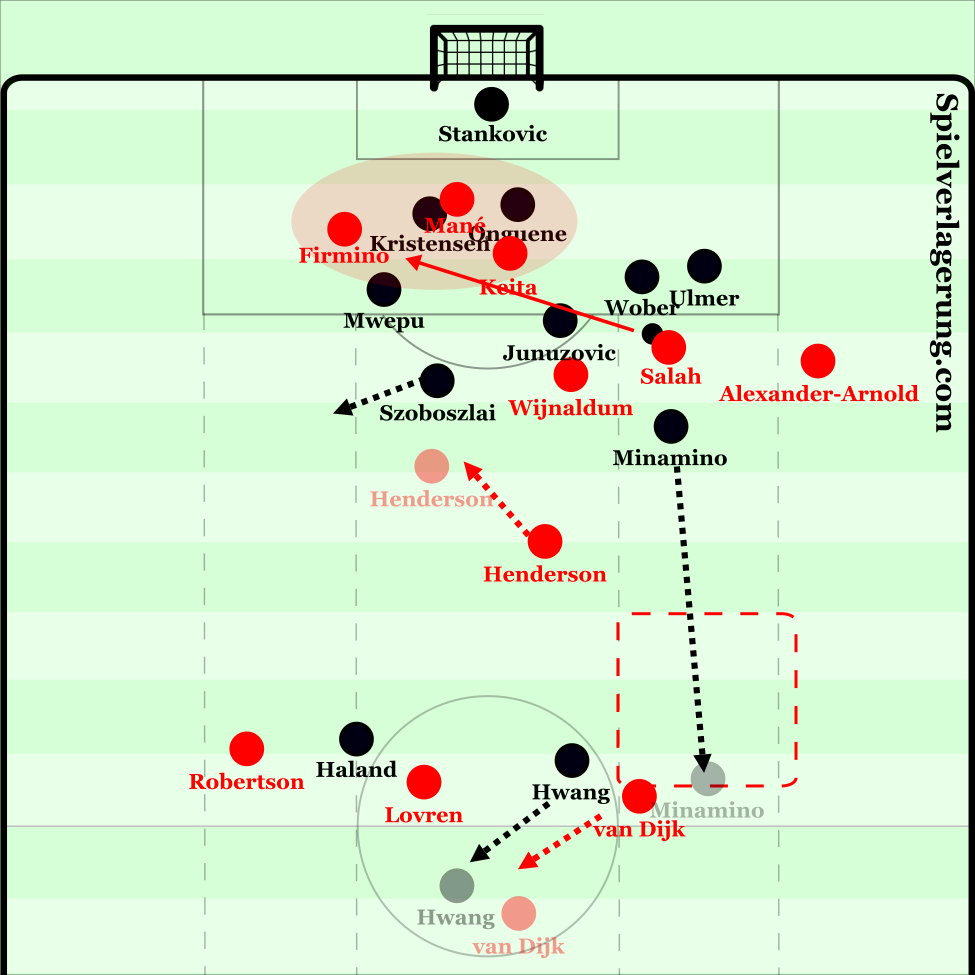
After the first 15 minutes, the game slowed down a bit, as Liverpool gained more control on the tempo. Even with Salzburg pressing them well, they were still able to create good chances from collecting 2nd balls & switching to the left-side -they often operated with ‘blind switches’, as they know that if someone had the chance to receive a ball, they far-side will be open-, where Mané & Robertson had advantageous situations to exploit the 1v1s/2v1s against the RB/Kristensen. Also, Firmino’s central role was the key here to stabilize Liverpool’s possession, as he offered diagonal options in between the line -often exploited by Alexander-Arnold-, plus in the attacking third his deeper positioning often pulled Minamino to close him, which opened spaces for Henderson, from where they were able to make switches to the far-sided full-back. At the end of the 1st half, the tempo raised again, often creating counters after counters, where neither teams had control on the midfield areas/central zone. This is the game dynamics, which much rather helps the better team, as eventually they will be able to exploit the vacated spaces -exactly what happened here. Even though Salzburg being able to create good chances after counter-attacks, still Liverpool had the biggest opportunities to score.
2nd half changes, Liverpool more stabilized
Just as they did in the 1st game, Liverpool again switched to a 4-2-3-1, but now already during half-time. Salah moved to the centre as the CF, Firmino into the #10 space/CAM, whilst Keita moved right as the RW. Besides, Klopp also fixed the build-up system, by forming a 4-2 with smaller distances between the CB-FB, as the FBs moved deeper to offer the main wide options. Here the circulation mostly happened between the 4 defenders, in order to move Salzburg’s shape horizontally to stretch them & exploit the opened spaces. Meanwhile Firmino now moved much rather to the centre -with same flexibility, and as Liverpool was able to circulate the ball faster, he could offer free options there, without the DM/Junuzovic being able to shift there in time to close these passing lanes. Also, with a better circulation, more spaced opened up for the FBs on the ball, from where they were able to combine with direct switches between each other – something they have already used in the 1st game, as it’s very effective against a diamond- in order to exploit the open ball-far spaces. The same happened before the 1st goal, as Alexander-Arnold was able to switch directly to Robertson, who after driving forward could find Mané with a diagonal pass between the lines -after stretching the diamond. This also had the positive effect on defending the counters, as now both FBs were deeper and they were able to close inside faster to tighten the last line, offering less time & space for Salzburg to exploit these gaps in counter-attacking situations. The switch also prevented the 2nd line shifts to the wider zones -wide zones controlled by the wingers, therefore Henderson-Wijnaldum could offer more stable support in front of the last line. As stated before, the half-time switch itself didn’t solve the problem, but reduced the number of situations, where Salzburg’s could advance through the centre. A Salzburg change was to put Haland wider -Daka’s role was the same after the sub-, to the outer shoulder of Alexander-Arnold, to offer a bit width against Liverpool’s tight back 4.
Moving Salah to the CF position also had a huge advantage. With Salzburg playing relatively open, Liverpool had good counter-attacking situations after collecting the 2nd balls, but as Firmino often positioned himself deeper in the 1st half to offer central control – as he usually do, functioning as a #10 for support-, they lacked a direct target player for potential throgh balls -even with Salah playing inside. This changed in the 2nd half, as now when Firmino or the CMs collected a 2nd ball or simply during building, Salah was immediately making runs behind the last line -situation before the 2nd goal. Here he also had a mismatch against Wöber, who couldn’t cope with this speed in these situations – that’s why Salah mostly made his runs from his side to exploit that. Also, both Mané and Keita moved wider, which forced Salzburg’s FBs to move out further, forcing their last line to shift horizontally more, stretching them, opening more space for Salah’s runs.
The switch to the 4-2-3-1/4-4-1-1 in defending also affected the defensive dynamics. Usually Liverpool forces opponents to play inside, where they are able to control the space, without being stretched with constant horizontal circulation. Although as Salzburg’s main offensive emphasis is on building/penetrating through the centre, it caused huge issues for Liverpool in controlling the central zone – lot of times Salzburg simply had better access here, collecting 2nd balls, advancing through here. That’s why the change to 4-4-1-1, plus the principle change to force Salzburg towards the wide areas was an optimal adjustment -this again shows how flexible Klopp’s game model is. Now Liverpool no further guided Salzburg towards the centre, but towards the wide zones (1st line to cut access between CBs – forcing them to pass to the FBs more, where Keita-Mané pressed them), from where they had less access/less optimal dynamics to exploit their central occupation, as now Pool could cover that better at the wide areas. All these changes positively helped Liverpool to stabilize the game’s dynamics, without Salzburg’s further adjustments – probably a switch then to build with 3 or a 2-2 structure might have been an optimal thing to do (as the build with 3 or 2-2 would have caused decisional crisis for Pool’s wingers where to guide the ball). Even though this game again showed some of Liverpool’s probable weaknesses -building against the diamond/high press, defending counters vs. central overload-,which offer valuable information for oppositional teams for the future.


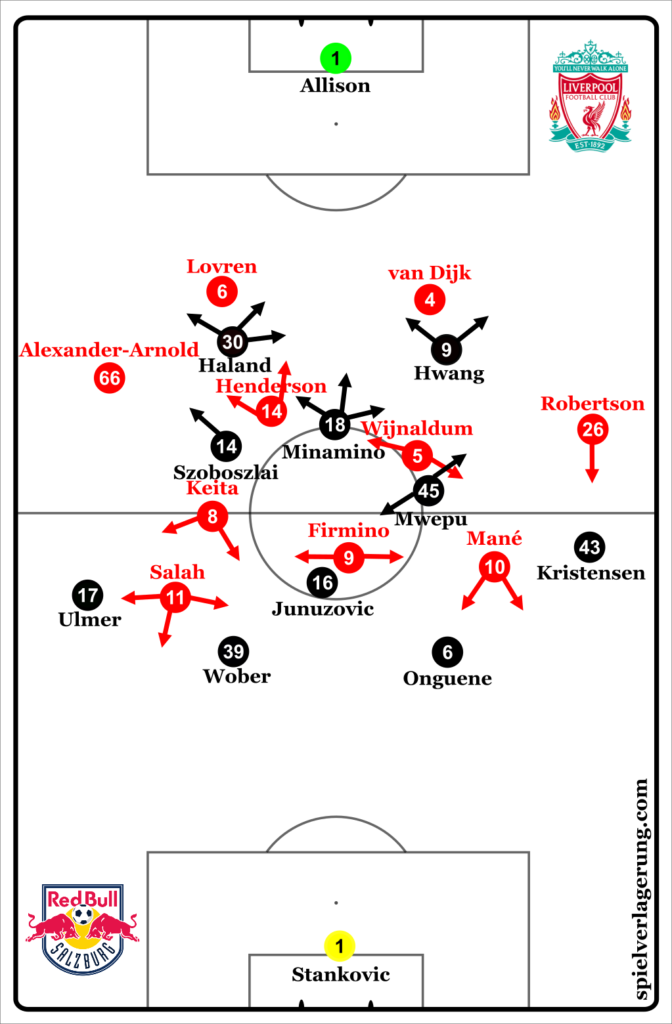
3 Kommentare Alle anzeigen
Peda December 12, 2019 um 8:42 am
Thanks for the analysis!
“Just as they did in the 1st game, Liverpool again switched to a 4-2-3-1, but now already during half-time.”
JD wrote in the analysis that Klopp reacted by tilting the back four, but looking at the tactical formation from the UEFA homepage you are right.
Looking at the players on the bench, how would you have reacted?
You talk about switching to a back 3 or 2-2 structure in build up. With Bernède and Farkas out you would have brought in Ramalho as RCB? The duo Junuzovic/Mwepu doen’t really work as a double pivot, at least not against such a high class opponent. What do you think about switching to a 4-3-3 (Daka for Haaland, he and Minamino wide) to strengthen and embrace the areas they where forced into?
IB December 12, 2019 um 5:27 pm
I thought about to make structural changes without any subs. Possibly Mwepu could have dropped deeeper next to Junuzovic or one of them to drop deeper to either halfspace.
Peda December 13, 2019 um 9:26 am
Occasionally, Salzburg’s structure looked a little asymmetrical in the last matches. Like they swing between a diamond and a 2-2 structure. That plays to the strengths of the different types in the starting eleven and should maybe have been embraced more here. Maybe Szoboszlai should have stayed wider and higher, staying between Henderson and TAA to have better access to the switches while Mwepu keeps deeper to cover for Junuzovic occasionally.
But in the end, I don’t think it would have made a big difference.
Salzburg does not have the bench to either make significant changes or keep the same high pace for over 90 minutes. And if we look at the goals and big chances, they also don’t have the necessary confidence and team coordination (is there a better translation for the German ‘Eingespieltheit’?) to shut down certain attempts. Before the first goal, especially Kristensen reacts poorly in my opinion.
That is more of an explanation than a criticism really. Besides having the better players, the top teams also have them for much longer periods. The last addition to the starting XI for Liverpool was Alisson last year. Haaland on the other hand may not even play for a full season before he is going to a bigger club.